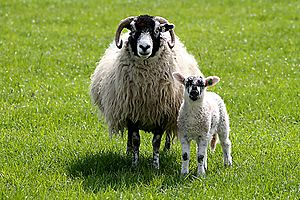Swaledale sheep facts for kids
The Swaledale is a type of domestic sheep named after the beautiful Yorkshire valley of Swaledale in England. You can find these sheep in many mountain areas across Great Britain. They are especially common in the Yorkshire Dales, County Durham, and the Pennine hills of Cumbria.
Swaledale sheep are easy to spot! They have off-white wool, cool curled horns, and white fur around their nose and eyes. Farmers raise them for their meat (lamb and mutton) and for their wool. They are also important for breeding other types of sheep, like the North of England Mule. Along with the Rough Fell, Herdwick, and Dalesbred sheep, Swaledales are one of four special sheep breeds found in the English Lake District.
Contents
What Makes Swaledale Sheep Special?
Swaledale sheep are super tough and perfect for the windy, open places where they live. They have thick coats, are strong, and very brave. Female Swaledales, called ewes, are amazing mothers. They can raise their lambs well, even when the weather is bad.
These sheep are a medium size. They have black faces with bright white fur around their nose and eyes. Both male and female sheep have curled horns, but the males' horns are much bigger. Their wool is thick and rough. It's usually a uniform white or off-white color.
Swaledale Wool and Meat
The wool from Swaledale sheep is strong and lasts a long time. It can be used for many things, but it doesn't sell for much money. The British Wool Marketing Board pays only about 40 pence for a kilo of this wool. Sometimes, the wool can have darker fibers mixed in, so some yarns made from Swaledale wool might look grey.
Swaledale sheep are also known for their tasty and tender meat, both lamb and mutton.
The History of Swaledale Sheep
Swaledale sheep are related to other tough mountain breeds like the Scottish Blackface and Rough Fell sheep. These breeds also do well in the high, open areas of the United Kingdom. We don't know the exact beginning of the Swaledale breed.
Long ago, in the 17th century, there was a sheep called the Linton. It was a common ancestor for Swaledale, Scottish Blackface, and Rough Fell sheep. The Linton sheep was named after the West Linton market in Peeblesshire. This market was famous for selling these hardy sheep to farmers in the Scottish Highlands and other hilly regions. In the early 18th century, the market sold over 9,000 sheep in just one day! This helped the breed become very popular in mountain areas.
The Swaledale Sheep Breeders Association
The Swaledale Sheep Breeders Association was started in 1919. It began with farmers who lived close to the Tan Hill Inn in North Yorkshire. Today, this association is still very active. It helps with selling Swaledale sheep, organizing shows, and promoting the breed.
Farming Swaledale Sheep
There are about 1,200 groups of purebred Swaledale sheep in the United Kingdom. Male Swaledale sheep, called tups or rams, can sell for a lot of money. On average, they go for £2,000 to £5,000. One special ram even sold for £101,000 at an auction!
Because Swaledale sheep are so hardy, farmers can raise them in remote and open places. They usually don't need to keep them indoors.
Products from Swaledale Sheep
Swaledale sheep provide both meat and wool that farmers can sell. Their meat is known for its good flavor and tenderness. While their wool doesn't get high prices because of its color and roughness, it's very strong and durable. This makes it great for things like carpets, rugs, and even insulation for homes. People also use the wool for spinning and knitting clothes, but this is less common.
Swaledale Sheep as a Symbol
The Swaledale sheep is an official symbol of the Yorkshire Dales. In 2003, there were plans to build a visitor center for Swaledale sheep in Kirkby Stephen, Cumbria. Kirkby Stephen was even called the "spiritual home of the Swaledale sheep." However, the town of Hawes in Yorkshire, which is also a big center for Swaledale sales, strongly disagreed. Hawes had its own plans for a visitor center.
Research on Swaledale Sheep Health
Scientists have used a group of Swaledale sheep to study a disease called scrapie. This is a serious disease that affects sheep. Researchers chose Swaledale sheep that seemed less likely to get the disease. They then bred these sheep to see if their offspring would be more resistant to scrapie. The research showed that the lambs born from these sheep were indeed better at surviving the disease.
The North of England Mule
A very successful sheep breed, the North of England Mule, is created by breeding Swaledale ewes with Bluefaced Leicester rams. The lambs from this cross are now one of the most common sheep breeds in lowland farming areas.
Images for kids




